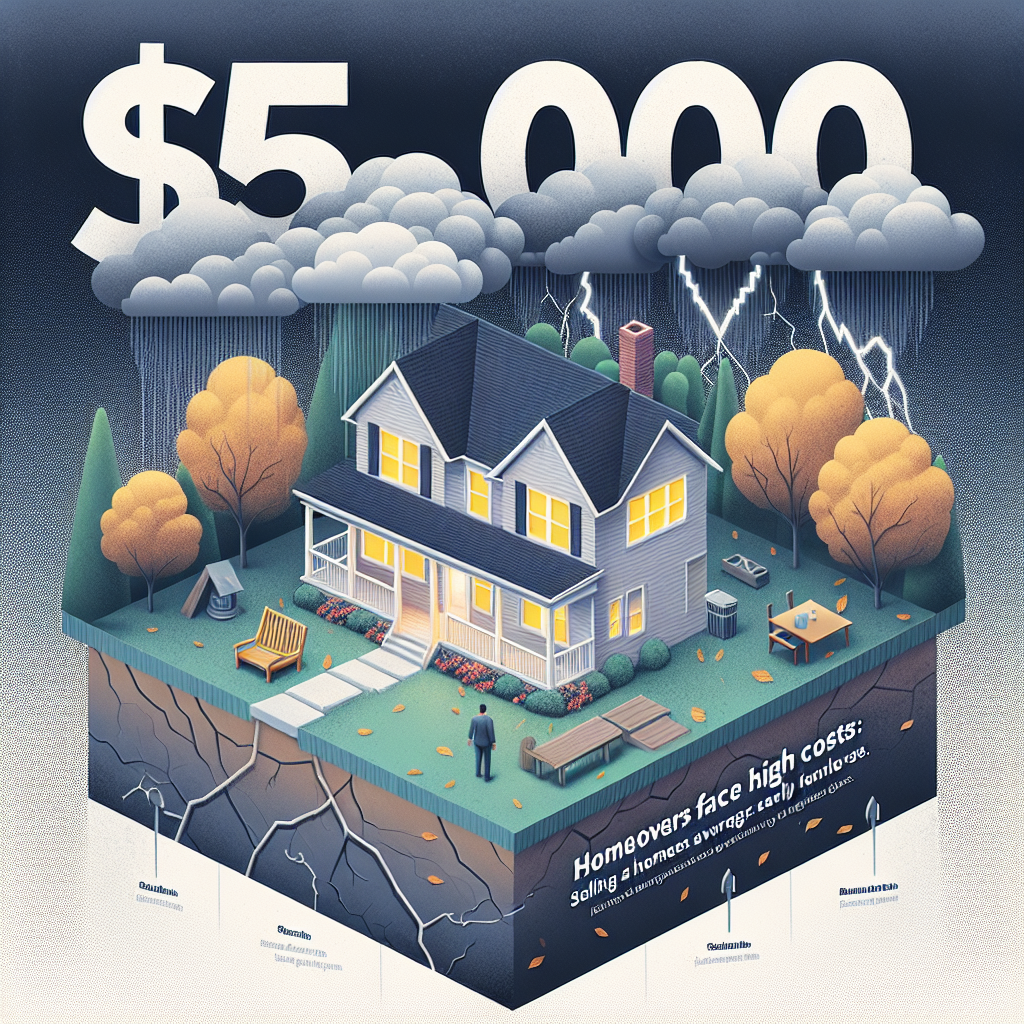-
Table of Contents
- Homeowners Face High Costs: Selling a Home Averages Nearly $55,000, Report Reveals
- Understanding the Breakdown of Selling Costs
- Real Estate Agent Commissions
- Home Repairs and Improvements
- Staging and Marketing
- Closing Costs
- Moving Expenses
- Case Studies: Real-Life Examples of Selling Costs
- Case Study 1: The Smith Family
- Case Study 2: The Johnsons
- Strategies for Managing Selling Costs
- Negotiate Agent Commissions
- Prioritize Cost-Effective Improvements
- Consider DIY Staging and Marketing
- Shop Around for Closing Services
- Plan Ahead for Moving Expenses
- The Impact of Market Conditions on Selling Costs
- Conclusion: Navigating the High Costs of Selling a Home
Homeowners Face High Costs: Selling a Home Averages Nearly $55,000, Report Reveals

In the ever-evolving real estate market, homeowners are often caught off guard by the substantial costs associated with selling their properties. A recent report has revealed that the average cost of selling a home in the United States is nearly $55,000. This figure encompasses a variety of expenses, from agent commissions to home improvements, and can significantly impact a homeowner’s net proceeds. This article delves into the various costs involved in selling a home, provides real-life examples and case studies, and offers insights into how homeowners can better manage these expenses.
Understanding the Breakdown of Selling Costs
Selling a home involves numerous costs that can quickly add up. These expenses can be broadly categorized into several key areas:
- Real estate agent commissions
- Home repairs and improvements
- Staging and marketing
- Closing costs
- Moving expenses
Real Estate Agent Commissions
One of the most significant costs in selling a home is the real estate agent’s commission. Typically, this fee ranges from 5% to 6% of the home’s sale price. For a home sold at $500,000, this translates to $25,000 to $30,000 in commission fees alone. While some homeowners may consider selling their homes without an agent to save on this cost, the expertise and market knowledge that a professional agent brings can often result in a higher sale price, offsetting the commission expense.
Home Repairs and Improvements
Before listing a home, many sellers invest in repairs and improvements to make their property more appealing to potential buyers. These costs can vary widely depending on the condition of the home and the extent of the upgrades. Common expenses include:
- Painting and minor repairs: $1,000 – $5,000
- Landscaping: $500 – $3,000
- Kitchen and bathroom upgrades: $5,000 – $20,000
While these improvements can enhance the home’s marketability and potentially increase its sale price, they also represent a significant upfront investment for the seller.
Staging and Marketing
Effective staging and marketing are crucial for attracting buyers and securing a favorable sale price. Professional staging services can cost between $2,000 and $5,000, depending on the size of the home and the extent of the staging required. Additionally, high-quality photography, virtual tours, and online advertising can add another $500 to $1,500 to the total marketing budget.
Closing Costs
Closing costs are another substantial expense that sellers must consider. These costs typically include:
- Title insurance: $1,000 – $2,000
- Escrow fees: $500 – $1,500
- Attorney fees: $500 – $1,500
- Transfer taxes: Varies by location
On average, closing costs can amount to 1% to 3% of the home’s sale price, adding thousands of dollars to the total cost of selling.
Moving Expenses
Finally, moving expenses can also contribute to the overall cost of selling a home. These costs can range from a few hundred dollars for a DIY move to several thousand dollars for professional moving services, especially for long-distance relocations.
Case Studies: Real-Life Examples of Selling Costs
To better understand the financial impact of selling a home, let’s examine a few real-life case studies:
Case Study 1: The Smith Family
The Smith family decided to sell their suburban home in California, which was valued at $600,000. Their selling costs included:
- Real estate agent commission (5%): $30,000
- Home repairs and improvements: $10,000
- Staging and marketing: $3,000
- Closing costs (2%): $12,000
- Moving expenses: $2,000
In total, the Smiths spent $57,000 to sell their home, slightly above the national average. Despite these costs, they were able to sell their home quickly and at a favorable price, thanks to the improvements and professional marketing efforts.
Case Study 2: The Johnsons
The Johnsons sold their townhouse in Texas for $350,000. Their selling costs were as follows:
- Real estate agent commission (6%): $21,000
- Home repairs and improvements: $5,000
- Staging and marketing: $2,500
- Closing costs (1.5%): $5,250
- Moving expenses: $1,500
The Johnsons’ total selling costs amounted to $35,250, which is below the national average. By carefully managing their expenses and working with a knowledgeable real estate agent, they were able to maximize their net proceeds from the sale.
Strategies for Managing Selling Costs
While the costs of selling a home can be daunting, there are several strategies that homeowners can employ to manage these expenses effectively:
Negotiate Agent Commissions
Real estate agent commissions are often negotiable. Homeowners can shop around and compare rates from different agents to find one who offers a competitive commission structure. Additionally, some agents may be willing to reduce their commission if the home is expected to sell quickly or if the homeowner is also using the agent to purchase a new property.
Prioritize Cost-Effective Improvements
Not all home improvements offer the same return on investment. Homeowners should focus on cost-effective upgrades that are likely to have the most significant impact on the home’s marketability. For example, fresh paint, minor repairs, and landscaping can enhance the home’s curb appeal without breaking the bank.
Consider DIY Staging and Marketing
While professional staging and marketing services can be beneficial, homeowners on a tight budget may consider DIY options. Simple staging techniques, such as decluttering, rearranging furniture, and adding fresh flowers, can make a home more inviting. Additionally, homeowners can leverage social media and online platforms to market their property at little to no cost.
Shop Around for Closing Services
Closing costs can vary significantly depending on the service providers used. Homeowners should obtain quotes from multiple title companies, escrow agents, and attorneys to find the best rates. Additionally, some states offer discounts on transfer taxes for certain types of transactions, so it’s worth exploring these options.
Plan Ahead for Moving Expenses
Moving costs can be minimized by planning ahead and comparing quotes from different moving companies. Homeowners can also save money by packing their belongings themselves and enlisting the help of friends and family for the move.
The Impact of Market Conditions on Selling Costs
Market conditions can also influence the costs associated with selling a home. In a seller’s market, where demand for homes exceeds supply, homeowners may be able to sell their properties more quickly and at higher prices, potentially reducing some of the associated costs. Conversely, in a buyer’s market, where supply exceeds demand, sellers may need to invest more in repairs, staging, and marketing to attract buyers.
For example, during the COVID-19 pandemic, many real estate markets experienced a surge in demand as buyers sought more space and remote work opportunities. This led to a seller’s market in many areas, allowing homeowners to sell their properties quickly and at premium prices. However, as the market stabilizes and interest rates rise, sellers may face increased competition and longer listing times, necessitating higher investments in marketing and home improvements.
Conclusion: Navigating the High Costs of Selling a Home
Selling a home is a complex and often costly process, with the average homeowner spending nearly $55,000 on various expenses. From real estate agent commissions to home repairs, staging, closing costs, and moving expenses, these costs can significantly impact a homeowner’s net proceeds. However, by understanding the breakdown of these expenses and employing strategies to manage them effectively, homeowners can navigate the selling process more efficiently and maximize their returns.
Ultimately, the key to successfully selling a home lies in careful planning, informed decision-making, and leveraging the expertise of real estate professionals. By taking these steps, homeowners can better manage the high costs of selling and achieve their financial goals.








